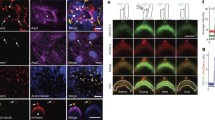Summary
This report summarizes our recent work on the role of intracellular Ca2+ ([Ca2+]i) in regulating mammalian ciliary beat frequency (CBF). CBF from a single ovine cilium and [Ca2+]i from the same cell were measured by digital video phase contrast microscopy and fura-2 ratiometric imaging video microscopy, respectively. Cells were stimulated with two exposures to 10 μM acetylcholine (ACh). CBF was recorded during the first and [Ca2+]i during the second stimulation. ACh increased [Ca2+]i and CBF transiently with indistinguishable kinetics and, early in culture, even induced [Ca2+]i oscillations and ciliary frequency modulations with the same peak-to-peak time interval. Cells treated with 1 μM thapsigargin, an inhibitor of the endoplasmic-reticulum Ca2+-ATPase, showed transient [Ca2+]i and CBF increases, again with similar kinetics, which often remained at an elevated plateau. Application of ACh to cells pretreated with thapsigargin produced decreases in both [Ca2+]i and CBF. Finally, changing extracellular Ca2+-concentrations induced corresponding changes in [Ca2+]i that were associated with kinetically similar CBF changes. These data strongly suggested that [Ca2+]i is a critical signal to regulate CBF in mammalian tracheal epithelial cells. In an initial effort to provide constraints on the number and type of reactions that link changes in [Ca2+]i to changes in CBF, simultaneous recordings of both signals from a single cell were analyzed. Such recordings provided higher resolution of the kinetic responses of CBF and [Ca2+]i to ACh as well as they allowed direct assessment of the coupling between [Ca2+]i and CBF. Simultaneous measurements revealed that [Ca2+]i and CBF were perfectly correlated within the CBF measurement time resolution, except for the period of the fastest changes in both signals during the initial ACh exposure. There, changes in CBF lagged the changes in [Ca2+]i by 1–3 ciliary beat cycles (ca. 150–450 ms).
Similar content being viewed by others
References
Di Benedetto G, Magnus CH, Gray PTA, Mehta A (1991) Calcium regulation of ciliary beat frequency in human respiratory eptihelium in vitro. J Physiol 439: 103–113
Fabiato A, Fabiato F (1978) Effects of pH on the myofilaments and the sarcoplasmic reticulum of skinned cells from cardiac and skeletal muscles. J Physiol 276: 233–255
Friderich G, Klumpp S, Russell CB, Hinrichsen RD, Kellner R, Schultz JE (1992) Purification, characterization and structure of protein phosphatase 1 from the cilia ofParamecium tetraurelia. Eur J Biochem 209: 43–49
Girard PG, Kennedy JR (1986) Calcium regulation of ciliary activity in rabbit tracheal expiants and outgrowth. Eur J Cell Biol 40: 203–209
Grynkiewicz G, Poenie M, Tsien RY (1985) A new generation of Ca2+ indicators with greatly improved fluorescence properties. J Biol Chem 260: 3440–3450
Habermacher G, Sale WS (1995) Regulation of dynein-driven microtubule sliding by an axonemal kinase and phosphatase in Chlamydomonas flagella. Cell Motil Cytoskeleton 32: 106–109
Hirano-Ohnishi J, Watanabe Y (1989) Ca2+/calmodulin-dependent phosphorylation of ciliary beta-tubulin in Tetrahymena. J Biochem 105: 858–860
Klumpp S, Cohen P, Schulz JE (1990) Chromatographic separation of four Ser/Thr-protein phosphatases from solubilized ciliary membranes ofParamecium tetraurelia by heparin-sepharose. J Chromatogr 521: 179–186
Lansley AB, Sanderson MJ, Dirksen ER (1992) Control of the beat cycle of respiratory tract cilia by Ca2+ and cAMP. Am J Physiol 263: L232–242
Naitoh Y, Kaneko H (1972) Reactivated triton-extracted models of paramecium: modification of ciliary movement by calcium ions. Science 176: 523–524
Salathe M, Bookman RJ (1995) Coupling of [Ca2+]i and ciliary beating in cultured tracheal epithelial cells. J Cell Sci 108: 431–440
—, Pratt MM, Wanner A (1993) Protein kinase C-dependent phosphorylation of a ciliary membrane protein and inhibition of ciliary beating. J Cell Sci 106: 1211–1220
Satir P, Sleigh MA (1990) The physiology of cilia and mucociliary interactions. Annu Rev Physiol 52: 137–155
— —, Barkalow K, Hamasaki T (1993) The control of ciliary beat frequency. Trends Cell Biol 3: 409–412
Tash JS, Krinks M, Patel J, Means RL, Klee CB, Means AR (1988) Identification, characterization, and functional correlation of calmodulin-dependent protein phosphate in sperm. J Cell Biol 106: 1625–1633
Thastrup O, Cullen PJ, Drobak BK, Hanley MR, Dawson AP (1990) Thapsigargin, a tumor promoter, discharges intracellular calcium stores by specific inhibition of the endoplasmic reticulum Ca2+-ATPase. Proc Natl Acad Sci USA 87: 2466–2470
Verdugo P (1980) Calcium-dependent hormomal stimulation of ciliary activity. Nature 283: 764–765
—, Raess BV, Villaion M (1983) The role of calmodulin in the regulation of ciliary movement in mammalian epithelial cilia. J Submicrosc Cytol 15: 95–96
Villalon M, Hinds TR, Verdugo P (1989) Stimulus-response coupling in mammalian ciliated cells. Biophys J 56: 1255–1258
Author information
Authors and Affiliations
Rights and permissions
About this article
Cite this article
Salathe, M., Bookman, R.J. Calcium and the regulation of mammalian ciliary beating. Protoplasma 206, 234–240 (1999). https://doi.org/10.1007/BF01288210
Received:
Accepted:
Issue Date:
DOI: https://doi.org/10.1007/BF01288210



